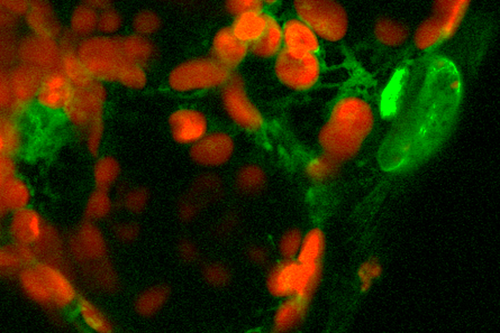Green “Power Plants”
A team of biologists has discovered a new control system that is important to how plants adjust to light
Nov 10, 2014
To plants, chloroplasts are vitally important, but also not entirely innocuous “boarders” within cells. A team of researchers is studying how communication between the two works.
Image Credit: Smileus/fotolia www.fotolia.com
Microscopic image of cotyledons of model plant Arabidopsis with chloroplasts (red) and the SIG5 protein (green)
Image Credit: Freie Universität Berlin
Plants can adapt to changing light conditions. This is made possible by photoreceptors that sense light at different wavelengths and translate it into signals – the language of cells. A group of biologists from Freie Universität Berlin and Heinrich-Heine-Universität Düsseldorf have jointly studied how the light signals affect the green “power plants” in the plant cells, the chloroplasts.
In the process, they discovered a new control system that enables light adjustment while at the same time protecting the plant from overreactions in the case of heavy light exposure.
Plants engage in photosynthesis, using the energy of sunlight to convert carbon dioxide and water into sugar and release oxygen. These reactions take place inside the plant cell, in special organelles called chloroplasts.
Chloroplasts were originally independent life forms similar to bacteria that were taken in, much like useful “boarders,” inside “host cells” during the evolution of the first plants. Chloroplasts are home to the reaction centers of photosynthesis: They convert light into energy and ultimately supply the plant with nutrients. For this system to function, communication and coordination between the chloroplasts and the “host cell” is vitally important.
Important – but Dangerous – Boarders
Chloroplasts are important “boarders” within cells, but they are also not entirely innocuous. Radicals and peroxides can also form during photosynthesis. These substances engage in chemical reactions with others, which can damage some elements of the cell.
This means that the plant has to support its chloroplasts, on the one hand, but also keep them in check on the other – they need to be sufficiently active, but not too active. How communication and control processes function between plant cells and chloroplasts is the subject of inquiry for the working group headed by Professor Margarete Baier at the Dahlem Centre of Plant Sciences at Freie Universität Berlin. Together with former working group members at Heinrich-Heine-Universität Düsseldorf, the group succeeded in describing a new control system within this communication and control network, which had previously only been partially understood. The results were published in the scientific journal Plants.
Communication in Both Directions
In their search for genes that are regulated to different degrees by light intensity and light quality, the biologists recognized the importance of the gene SIG5. The SIG5 protein moves into the chloroplasts, where it increases the components available for photosynthesis. Production of SIG5 is dependent on light. The more light is present, the more photosynthesis is promoted. This converts the available light energy optimally into chemical energy, ultimately also leading to synthesis of energy-rich organic compounds.
At the same time, the researchers were able to show that plants can deactivate SIG5, which acts as a kind of “brake” to prevent their green power plants from “overheating” and damaging the chloroplasts. If excessive amounts of light cause a buildup of electrons in the chloroplast, the chloroplast sends a signal that the photosynthesis machinery is overloaded and turns off the SIG5 gene in the nucleus. As a result, less SIG5 is produced, so fewer components of the photosynthesis reaction centers are produced as well.
This alternation between activation and deactivation shows that SIG5 plays a key role in plants’ adaptation to light. Acting as an intelligent intermediary, it is able to integrate and forward signals from different sources and with different effects.
Further Information
Dr. Diana Mutz, Dahlem Centre of Plant Sciences, Freie Universität Berlin, Tel. +49 30 838-56214, Email: diana.mutz(at)fu-berlin.de


